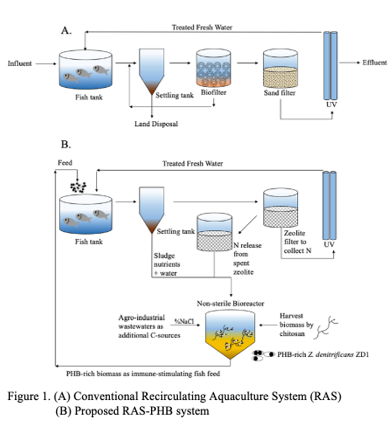AN INNOVATIVE WASTE-TO-FOOD RECIRCULATING AQUACULTURE SYSTEM FOR WASTEWATER REUSE AND ANTIBIOTIC-FREE AQUAFEED PRODUCTION
Recirculating aquaculture system (RAS) plays a vital role in the sustainability and commercial viability of aquaculture that provides a significant protein source to human nutrition. Despite that RAS reduces water demand and allows for year-round intensive production , intensive aquaculture leads to common challenges such as wastewater /waste management, high feed cost, and most importantly, the widespread use of antibiotics and the increasing ineffectiveness of antibiotics against aqua species pathogens. Therefore, there is an urgent need for a cost- effective approach to overcome these challenges for sustainable aquaculture .
This study developed a novel RAS-polyhydroxybutyrate (PHB) system ( called RAS-PHB) to address the challenges described above. The RAS-PHB system can produce PHB-rich biomass (single-cell proteins, SCPs) as healthy aquafeed from aquaculture wastewater/wastes . The PHB-rich SCPs are rich in protein and contain high PHB as a biocontrol agent and immunostimulant , eliminating the need for antibiotics and improving the survival and growth of aquatic species. The configurations of RAS-PHB system and conventional RAS are illustr ated in Figure 1. Briefly, the sand filter in conventional RAS (Figure 1A) is replaced with a zeolite sorbent unit to recover nutrients (particularly ammonia). T he biofilter is also substituted with a nonsterile bioreactor for cultivating PHB-producing SCPs using nutrients recovered from the sorbent unit and supplemental carbon sources like agro-industrial wastes. Finally, chitosan as a nontoxic , healthy bioco agulant was used to harvest PHB-rich SCPs as an aquafeed (Figure 1B). The composition of the PHB-rich SCPs produced from various wastes was analyzed and compared to conventional aquafeed s. A simple analysis was performed to compare the economic advantage of using the proposed RAS-PHB over the traditional RAS system.
